
Baby Krishna stealing ghee
Ghee, a form of clarified butter, is a well known cooking fat. What is less known in the West is that it is also used for skin care and as medicine in Ayurveda. In fact, it’s basically a panacea in Ayurveda. I’m no expert in Ayurveda, but it is interesting to know that it has such a long track record in India as a topical treatment.
What I have discovered so far is pretty neat. It is in the nature of ghee to sink into the skin rather than sit on the surface. This makes it a really excellent moisturizer. It is not the type of moisturizer which seals in moisture, or protects you from the elements, but it immediately soothes dry and chapped skin.
For instance, during my last head cold, I used it on my much-abused nose. The ghee saved my nose and my lips from a terrible case of chapping. I always keep my lips and nose balmed-up during a cold, but the ghee worked better than anything else I’ve ever used, in terms of absorption, relieving discomfort and quick healing.
Since then, I’ve been using it on my face and hands to fend off the dry, itchy skin of winter. Since it sinks in so fast, it helps to use it in conjunction with another moisturizer, one which stays on the surface of the skin, to seal everything in.
Color me totally fascinated with ghee. There’s much research to be done on it here at Root Simple.
Here’s an interesting fact: ghee doesn’t go bad. Ever. In Ayurveda, aged ghee is particularly treasured.
See, butter becomes ghee when you remove the sugars and proteins and water, leaving only fat. Without that other stuff in it, the fat alone can’t go bad. Ghee’s only enemy is water–which is true of all fat-based foods and cosmetics. Water sets up conditions for bacteria to breed. So keep your ghee dry. In fact, you should never store it in the refrigerator, because this may cause condensation inside the jar, which will lead to spoilage. Just keep it on the shelf, and scoop it out with a dry spoon, and it will keep until it’s all gone.
That’s all I have to say on ghee, so far. I don’t know much yet, but I like the way it feels. More will follow, I am sure. I’m going to experiment with making body butter and lip balm with it.
Do any of you use ghee for medicine or skin care?
(Also, I’ll be making my own ghee soon, and will post on that, but in the meantime, there are loads of recipes for it out there. It’s basically just boiled butter–anybody can make it. You can also find it ghee in many “regular” super markets these days, as well as in health food stores and of course, Indian markets.)

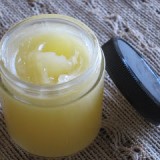
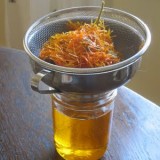
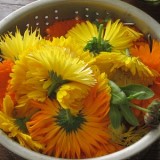
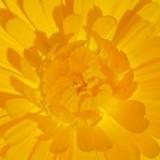
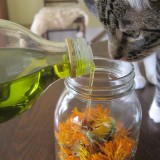
Very interesting, I did not know about Ghee. I may try it.
I use olive oil/castor oil on my face, it cleans and moisturizes, so no need for other lotions. I made my own lotion and lotion bars but I do find them rather greasy, and they do take a while to be absorbed. I’ve managed to put a few greasy fingertip marks around the house.
I wonder if Ghee is less greasy
Ok off the google
Have been making Ghee for a while now, but have never used it cosmetically. and all other oils I use in my lotions and potions do turn. looking forward to your experiments and will be adding my own. thanks!
This information turns on its head everything I thought I knew about fats. Is it possible to rid ghee of sugars, protein, and water if it is done at home? I have seen directions for canning in a pressure canner, but there is always a bit of something on the top of the product in the jar. Would canning it with a stray bit of protein still be okay?
Do you ever can it for long-term storage? Long-term–like beyond its natural shelf life. Or, can pure ghee just sit on a shelf for years with no undue consequences.
In the winter I need to just be buttered down with ghee because I itch so with dry skin.
Have you tried jojoba oil? I used to get raw and chapped skin at the corners of my mouth or where my nose meets my face. Lotions never helped and sometimes burned, and I recall it taking two weeks of it getting worse before getting better. Then I tried jojoba, and it would get better within a couple days, and no irritation. You do end up looking greasy though, but eh!
I’m sorry, for some reason this has me thinking of the scene in “The Handmaid’s Tale” where she uses a pat of butter as a moisturizer because they won’t let her have anything else. lol. I do think it’s interesting that Ghee is so different from butter. Much like coconut oil it has so many other uses as well as being delicious!
No worries–I’m permanently traumatized by The Handmaid’s Tale as well. 😉
ok so i am positive this is user error…..but i followed a recipe on line….and it seemed to go well….and looked like the pics…..so i smeared it all over my face…..and i smelled like a grilled cheese sandwich……not sure what i did wrong…….but….user error 🙁 ……
at least the birds got a snack during the snow…..i slathered it all over some bread for a snack for them.
Did you strain out the browned solids?
i did – and it was nice and creamy and soft and same color like on the job aid and here…..i reread the directions and maybe because i used regular butter and not unsalted?? but it did say “preferably” and not like the salted would ruin it…..i don’t usually have butter in the house but i had a stick left over from baking and thought i would try….well next time i have any leftover maybe i will try it again!
I’ve never used ghee for skincare, but I can attest to the benefits of using tallow in a similar way. Yay for animal fats! Maybe our bodies have an easier time incorporating them?
I love cooking with homemade ghee, but I guess I have another use for it now as well 🙂
Thanks for mentioning about the cosmetic uses of ghee. I make a cream out of ghee just by washing it in distilled water for 50 times and adding saffron to it..trust me its the best cream I have ever used.
I generally use store brought grass fed organic ghee, but would definitely love to make my ghee some day..Is it a difficult task?